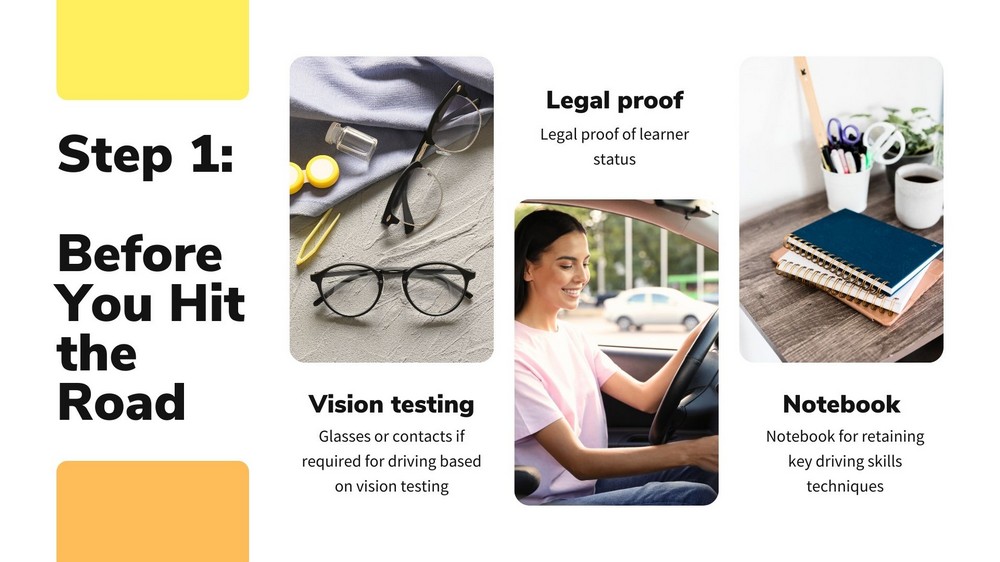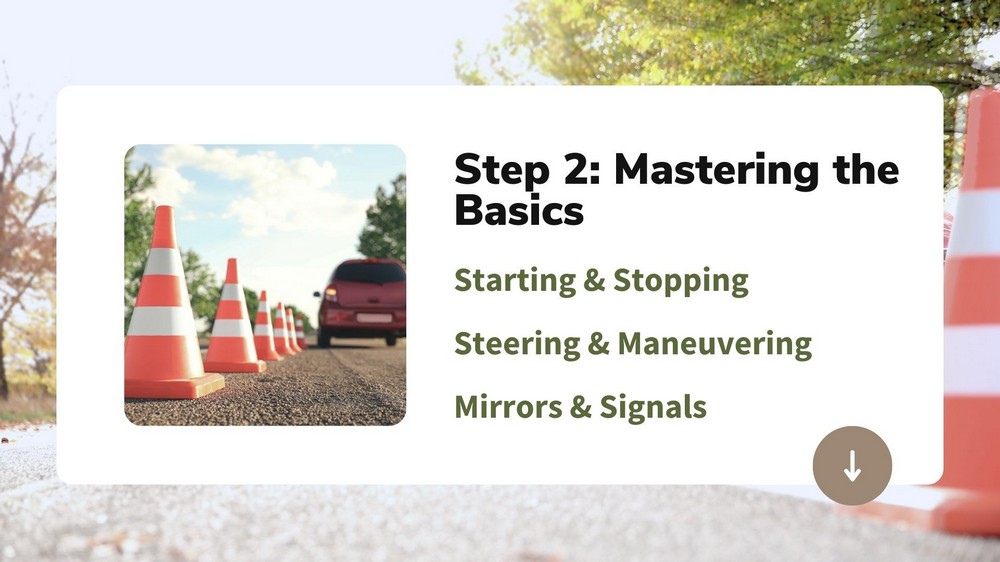Step-by-Step Driving Lessons for Beginners: Conquer the Road with Confidence!

Table of Contents
- The Anxieties Beginners Face
- Why Step-By-Step Learning is Essential
- This Guide Provides a Roadmap for Success
- Step 1: Before You Hit the Road
- Step 2: Mastering the Basics
- Step 3: Building Confidence on the Road
- Step 4: Advanced Skills & Practice
- Step 5: Preparing for the Driving Test
- A Roadmap for Driving Confidence
Looking for a trusted driving school in New York? Our beginner-friendly lessons are designed to help you build confidence and master the road.
Learning to drive can seem terrifying at first. Between memorizing intricate rules of the road and controlling a multi-ton vehicle, it's no wonder new drivers often feel overwhelmed. However, with structured driving lessons tailored to beginners, aspiring motorists can gain skills and confidence behind the wheel. This article will provide a roadmap to educate beginner drivers on what to expect from introductory driving lessons and how to prepare for the open road.
The Anxieties Beginners Face
Getting started with driving lessons brings a whirlwind of emotions. Excitement to get behind the wheel is quickly replaced by anxiety when confronted by the complexities of driving. Without a clear structure, beginners can easily become frustrated and lose motivation. Even teens who have long awaited their chance to drive can develop last-minute fears as they prepare for their first on-road session. It's critical to acknowledge these difficulties upfront rather than assuming new drivers will work through frustrations on their own.
Beginners love our beginner-friendly driving school packages with step-by-step coaching and simulator time.
Why Step-By-Step Learning is Essential
Because driving requires managing multiple skills simultaneously, introducing lessons systematically establishes strong fundamentals before adding new challenges. Attempting overly advanced maneuvers too quickly can undermine beginners' confidence. On the other hand, constantly reviewing the same basic operations can bore new drivers. With a purposeful progression of manageable lessons, novice motorists can build real road readiness at their own pace.
This Guide Provides a Roadmap for Success
The remainder of this article will explore a practical five-step sequence for introductory driving lessons, from what to expect before getting behind the wheel to preparing for the driving exam. Along with explaining essential driving competencies, we'll address common beginner pitfalls and provide tips to ensure new drivers feel empowered every mile of the learning journey. Soon, nervous newcomers will learn to drive with assurance and excitement.
Call Us Today 6AM-10PM
Or fill out the form 24/7
Our team is here to guide you with promotions, instructor availability, and the best training package for you.
Step 1: Before You Hit the Road

Before beginning actual driving, several key steps allow beginner drivers to familiarize themselves with driving basics. Securing the proper paperwork, selecting an instructor, and learning about the vehicle may not involve turning the ignition yet, but they establish critical context for maneuvering on the road.
Preparing the Learner
Depending on your region's regulations, becoming eligible for driving lessons may require obtaining a learner's permit by passing written exams on road signs and rules. Studying manuals like state driving handbooks helps ensure you pass on the first try. Links like how to prepare for a driving test provide valuable driving test pointers.
Once achieving learner status, beginners should gather essential supplies before lessons commence, including:
- Legal proof of learner status
- Notebook for retaining key driving skills techniques
- Glasses or contacts if required for driving based on vision testing
Choosing the Right Instructor
Selecting the proper driving instructor heavily influences novice drivers' early experiences behind the wheel. Key factors to consider include:
|
Instructor Attribute |
Considerations |
|
Qualifications |
Verify instructors hold valid state certification for teaching driving |
|
Methods |
Determine if the instructor's curriculum follows a structured sequence of skills-building |
|
Communication Style |
Ensure you'll understand guidance; chatty vs. reserved personalities differ |
|
Rapport |
Schedule trial driving sessions with prospective instructors to confirm you feel comfortable asking questions and receiving feedback |
|
Specialization |
Seek instructors with backgrounds aligned to student needs, like adaptive lessons for those with disabilities or refresher courses for adults who never completed licensing requirements |
Spending time vetting and selecting the optimal driving instructor saves headaches throughout the learning process. Many driver education companies offer convenient search tools to filter potential instructors by attributes like language competency, gender, and availability.
Vehicle Familiarization
Whether practicing in your own or the instructor's car, beginners should dedicate time upfront exploring core vehicle parts involved in driving, including:
- Primary controls like the steering wheel, accelerator, brake, and gear selector
- Dashboard displays for speed, fuel level, and engine temperature
- Adjustment levers for mirrors and seat positioning
- Safety components like seat belts and air bags
Grasping these basics permits students to focus wholly on road skills once driving commences. Additionally, familiarity builds confidence for practical steps like starting the vehicle, which can intimidate inexperienced motorists.
With administrative tasks completed, essential gear on hand, and a proficient instructor secured, anxiety melts away as novice drivers prepare to navigate public roads for the first time. However, fundamentals remain vital before hitting the gas. Let's shift gears into creating rock-solid driving basics.
Call Us Today 6AM-10PM
Or fill out the form 24/7
Our team is here to guide you with promotions, instructor availability, and the best training package for you.
Step 2: Mastering the Basics

With administrative preparation complete, beginner motorists can finally explore core driving techniques, starting with the most essential operations like starting, stopping, and steering. As confidence grows, new skills integrate until managing the vehicle becomes second nature.
Starting & Stopping
The first hands-on lessons focus on activating the car and easing into motion safely using the following process:
- Instructor ensures parking brake is engaged before student starts engine
- Student checks mirrors and blind spots for obstacles
- Student shifts gear selector into Drive while brake pedal is pressed
- Student releases parking brake as instructor oversees surrounding area
- Student signals intent to enter roadway then checks over shoulder
- Student releases brake pedal slowly, allowing car to edge forward into motion
- Student stops smoothly by easing onto brake pedal rather than harsh braking
Practicing starts, stops, and subtle acceleration allows novices to hone clutch and brake coordination vital for all driving scenarios. Having an instructor available to cover additional pedals inspires confidence while maneuvering at low speeds.
Steering & Maneuvering
Initially, the sensation of controlling a moving ton of metal with small wheel movements proves exciting but disconcerting. However, steering quickly becomes second nature by applying a few key techniques:
- Sit comfortably and adjust mirrors to maximize visibility
- Grip wheel at 9 and 3 o’clock hand positions
- Scan ahead of the vehicle to choose driving path
- Rotate wheel gently to follow roadway rather than jerking motions
- Allow wheel to glide back to center slowly as vehicle straightens
With steering basics instilled, beginners can start navigating turns and curves. Instructors will demonstrate "hand-over-hand" guidance for wheel handling, where the pushing hand slides up the wheel during a turn.
Learners also begin moving the car with precision in confined zones. Guided practice with subtle accelerator and brake adjustments in parking lots prevents panic in tighter real-world spots.
Mirrors & Signals
Frequently checking mirrors becomes second nature with time but demands reinforcement early. The "Mirror-Signal-Maneuver" mantra helps cement this habit, ensuring students evaluate surroundings before changing direction. Practicing blinker usage for basic turns, lane changes, and merges or exits builds muscle memory for indicating intent, preventing accidents due to uncertain movements.
As core car controls feel comfortable, beginners prepare to confront public roads. But first, they need context on navigating the rules and features governing all driving environments.
Step 3: Building Confidence on the Road

With in-vehicle fundamentals established through methodical lessons, new drivers stand equipped to experience realistic traffic scenarios. While basic skills suffice for parking lots and side streets, highway integration and busy intersections ratchet up complexity. Internalizing regulations and expectations guides beginners in diverse driving contexts.
Traffic Laws & Signs
Before confronting crowded roads, each beginner must grasp standard traffic directives like:
- Right-of-way standards dictating yielding protocol
- Speed limit changes from zone to zone
- Location-specific restrictions for passing other vehicles
- Signage colors and shapes indicating warnings, orders, or notifications
Instructors ease students into busier driving environments once convinced they can identify and interpret common markers. Early exposure allows learners to clarify rather than develop incorrect assumptions that prove dangerous long-term.
Intersections & Roundabouts
Cross-traffic intersections require vigilance from all drivers but particularly challenge beginners lacking experience gauging oncoming vehicle speeds quickly. Learning drivers may practice:
- Scanning multiple directions for incoming cars
- Covering brake pedal in case of sudden stopping needs
- Claiming an open lane decisively yet cautiously
- Double-checking all ways before proceeding through
Similarly, multi-lane roundabout navigation integrates anticipation, positioning, and signaling for safe circulation. Learners initially stick to single-lane roundabouts then expand to more complex configurations.
Highway Driving
For many novice motorists, the prospect of merging onto fast highways triggers nerves. Instructors demystify the process by illustrating techniques like:
- Accelerating adequately in merging lanes to match highway speed
- Identifying safe gaps between same-direction cars
- Quickly matching existing traffic pace post-entrance
- Switching lanes methodically rather than abruptly
With essential driving capabilities gained through incremental challenges, student growth accelerates - much like properly accelerating onto the highway itself! Before exam readiness, a few advanced lessons produce extremely competent beginners.
Step 4: Advanced Skills & Practice
With basic operations, rules of the road, and real-world driving under their belts, novice motorists prepare for trickier situations by honing additional techniques. Parking refinements, night visibility tactics, and inclement weather expertise transform beginners into skilled drivers ready for solo journeys.
Parking
While new drivers often dread parallel parking, its utility for navigating tight urban spots necessitates practice. Instructors demonstrate not only aligning within lines but also starting on inclines without drifting and safely exiting spaces set closely between other cars. Useful pointers include:
- Positioning alongside the front car's rear near the open space's center
- Aligning your rear axle with the back car's front axle when reversing
- Straightening wheels before backing fully into the spot
- Pulling forward if initial alignment needs adjustment
Hill starts present another common anxiety for novices learning standard transmissions but grow intuitive through rehearsal. Clutch pedal finesse prevents drifting when facing uphill openings.
Night Driving
Many driving environments transform once daylight fades, compromising visibility, illumination, and landmark familiarity. Before teen drivers embark independently after dark, initial coached sessions ensure preparedness by covering skills like:
- Adjusting mirrors and seating for glare avoidance from behind
- Interpreting roadway horizons obscured by darkness
- Approaching turns and intersections with heightened caution
- Maximizing illumination from headlights without blinding oncoming traffic
Adverse Weather Conditions
Especially for new motorists in regions with seasonal swings, recognizing vehicle control adaptations for rain, snow, and other inclement weather improves all-conditions aptitude:
- Braking earlier since slick surfaces lengthen stopping time
- Steering lightly and accelerating gradually to avoid skidding
- Allowing ample distance from other cars to prevent multi-car pile-ups
- Scanning for faded lane markers covered by snow or water
As beginners acclimate to trickier scenarios with coaching, only the final challenge of demonstrating skills proficiency under exam pressure remains!
Step 5: Preparing for the Driving Test
After methodical lessons spanning parking lots to highways, the prospect of formal driving test evaluation looms. While exams validate capabilities, many beginners find them stressful. Targeted preparation and an understanding of typical test components reduce anxiety while ensuring learners showcase their progress.
Understanding the Test Format
Local motor vehicle departments outline specific driving test policies, but most share common contours:
- Verifying legally mandated documentation
- Demonstrating vehicle safety knowledge through verbal Q&A
- Exhibiting driving skill during a 15-30 minute monitored on-road session
- Performing particular maneuvers like parking, 3-point turns, or hill starts
- Accumulating driving errors which may result in failure if exceeding thresholds
Instructors walk students through what to expect, making test protocols feel less intimidating.
Pre-Test Practice
Similar to any vital exam, realistic pre-tests build confidence by identifying areas needing refinement before the actual event. Dedicated practice sessions in the weeks leading up to formal evaluations help teens and adult learners iron out lingering uncertainties. Key tips include:
- Maintaining driving routines like mirror checks and signaling
- Speaking through thought processes to showcase hazard recognition
- Performing tricky maneuvers like backing up or parallel parking
- Pointing out traffic signs to demonstrate rules comprehension
Staying Calm & Confident
Despite thorough preparation, exam anxiety can undermine road readiness. Rather than dwell on potential mistakes, remind yourself:
- Tests validate months of skills gained through quality lessons
- Examiners look for safe execution rather than perfect runs
- Deep breaths and visualization calm nerves pre-test
- Keeping focus on the road prevents distractions
- You know the basics; trust your instincts
With measured preparation aligned to exam particulars, new drivers can ace their tests and hit the open road solo, prepared for wherever the journey leads!
A Roadmap for Driving Confidence
Learning to drive opens life possibilities yet challenges newcomers with simultaneous coordination of hands, feet, eyes, and brains. Without structured guidance, beginners struggle piecing together disparate skills into safe driving habits. This article presented a step-by-step sequence for introductory driving lessons to establish confidence beyond simple car operation to assured roadway integration.
By framing essential novice competencies from choosing an instructor through acing license exams, we've mapped a deliberate learning arc adaptable across regions. Now first-time drivers can pursue mastery without sacrificing confidence. With beginnings safely secured, we wish our newly empowered motorists blue skies ahead as they cruise open roads into bright horizons!
Call Us Today 6AM-10PM
Or fill out the form 24/7
Our team is here to guide you with promotions, instructor availability, and the best training package for you.
Frequently Asked Questions
-
How many driving lessons will I need?
The number of lessons needed varies per student, but research shows most new drivers require about 20-30 hours of instruction plus additional practice before testing readiness. Lessons should continue until both instructor and student feel fully prepared.
-
When should I start driving lessons?
Experts recommend beginning lessons shortly after obtaining your learner's permit. Combining driving practice with studying rules and signs makes lessons more meaningful. Starting too close to testing creates unnecessary pressure.
-
What age is best for a first driving lesson?
While legal ages differ across regions, many instructors find 15-16 year old learners open to guidance without developing poor habits from unstructured practice. However, adult beginners bring greater maturity to focus on lessons.
-
Should I use a driving school or private instructor?
Quality driving schools screen and train instructors, but private mentoring allows tailoring lessons to individual pace and learning style. Compare options to pick the approach suiting your needs and budget.
-
How do I calm first-time driving nerves?
Anxiety is common for beginners but lessens through preparedness. Understanding vehicle controls and testing specifics ahead helps. Share concerns openly with your instructor and have them demonstrate maneuvers to inspire confidence.
-
What if I don't pass my first driving test?
The pass rate for first tests often falls below 50%, so view it as final preparation. Analyze any mistakes made to guide further practice. Book your retest as soon as eligible, when knowledge remains fresh. Most succeed by their second attempt.
 English
English Spanish
Spanish 

